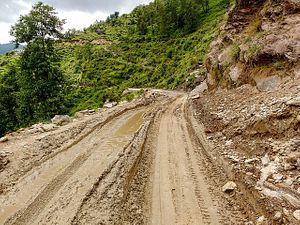India’s Himalayan foothill region is one of the world’s most densely populated but least developed areas, with economic growth lagging globally connected coastal states like Goa, Gujarat, and Maharashtra. Embracing the well-worn growth strategy of infrastructure investment, the Indian government has pledged to improve road connectivity to these and other isolated regions. The initiative would reduce travel times, facilitating the movement of people to job centers and products to new markets. However, this strategy also carries an unexpected environmental price. As consumer products are more easily transported to isolated regions, new types of waste are being burned or dumped in ecologically sensitive areas. While expanding consumer choice, road connectivity has raised challenges in how to more sustainably manage waste from toxic plastics.
It is canonical that infrastructure projects be assessed holistically; that is, not only for their direct environmental impacts but also for their inducement of unsustainable human behaviors. However, the latter often receives less attention. With governments focusing primarily on issues like wetlands destruction, natural habitat loss, human displacement, and natural resource depletion, the consequences of changes in human behavior are often overlooked, and can be difficult to anticipate and quantify. Moreover, reactively addressing such behaviors can be costly and ineffective, particularly as embedded cultural and institutional practices are difficult to change through policy.
These challenges are particularly acute in developing countries. The promise of rapid industrialization lures governments to embrace “big-bang” infrastructure: highways, dams, airports, and energy production facilities, among others. Introduced with great fanfare, these projects boast impressive metrics: big budgets, reduced travel times, and more connected markets. Although academics and analysts have developed robust metrics to quantify the environmental impacts of infrastructure projects, sustainability advocates predictably meet skepticism from groups that benefit from development (e.g. politicians, contractors, and investors). As such, the political salience of environmental sustainability is weak in developing countries. Infrastructure can also perpetuate unsustainable human behaviors at both the individual and firm levels; this problem is particularly acute where corporate regulations and enforcement are weak.
Developed countries are likewise subject to the negative environmental impacts of infrastructure-induced human behavior. A common example is the United States’ interstate highway system. While the interminable decades-long project has connected previously isolated rural areas to larger cities and markets, it has contributed significantly to suburban sprawl – the unfettered encroachment of development on rural areas at the urban fringe. In the United States, vehicle miles traveled (VMT) per capita rose steadily throughout the second half of the 20th century, with automobile congestion exacerbating air pollution. In car-dependent Los Angeles, city and state leaders adopted aggressive measures to reduce pollution, including emissions controls on automobiles and regulations on industry. In an alternative scenario, understanding changes in long-term behavioral patterns (e.g. more driving) might have compelled planners to support alternative modes and denser development; efforts are now underway to retrofit Los Angeles with broader transit coverage, but the infrastructure gap is sizable. Other types of infrastructure, including that for water, electricity, and petrol, can induce consumer wastefulness by reducing per-unit costs; a “moral hazard” emerges when users overconsume on the assumption that supply is plentiful, reliable, and cheap. Policy intervention for demand management entails pricing the good at cost-recovery or higher, but water, electricity, and petrol are often subsidized – in both developing and developed countries. The resulting overuse can have negative environmental consequences, all initiated by a combination of improved infrastructure and distortive pricing.
Capital-intensive infrastructure is planned and delivered primarily at the central government level. States and localities often lack the resource capacity to initiate large-scale development on their own. However, it is at the local level where knowledge about behavior patterns – and the culture that influences them – resides. Two forces should facilitate the incorporation of local knowledge into infrastructure assessment and planning. The first is decentralization – power-sharing reforms that boost local autonomy as central governments shed responsibilities. The second is democratization – both an institutional reform managed by government and a grassroots force supported by knowledge sharing platforms (e.g. social media) and mobilization of citizens around issues like representation. This type of democratic action, in forms such as local elections and participatory governance, reduces the theoretical distance between policymaking and human behavior, and can provide the feedback that prevents costly oversights in infrastructure planning.
The trade-offs of economic growth are evident in the many regions where pollution endangers public health; for example, China has maintained decades of high growth but with high costs to air and water quality. Nevertheless, infrastructure development is too often seen as a false choice – bringing electricity to a rural village or improving market access to foothill regions should not force citizens to suffer the effects of environmental degradation. Further, the consequences of unsustainable human behavior must be openly acknowledged by planners and policymakers – and also by citizens themselves. While burning garbage from newly accessible products may be cost effective and expedient, it is an unsustainable solution that reveals both deficiencies in other infrastructure (e.g. energy and waste management) and gaps in environmental literacy. With improved technologies and government expertise, in addition to more democratic systems, infrastructure development and environmental sustainability should no longer be incompatible. The hurdle, then, is political will. When costs to the environment and public health are found to outweigh the benefits of growth, will governments embrace smarter infrastructure or ignore environmental and social welfare? So far, economic expediency continues to drive the infrastructure agenda, with potentially grave consequences.
Kris Hartley is a Lecturer in the Department of City and Regional Planning at Cornell University, and a non-resident fellow at the Chicago Council on Global Affairs.

































